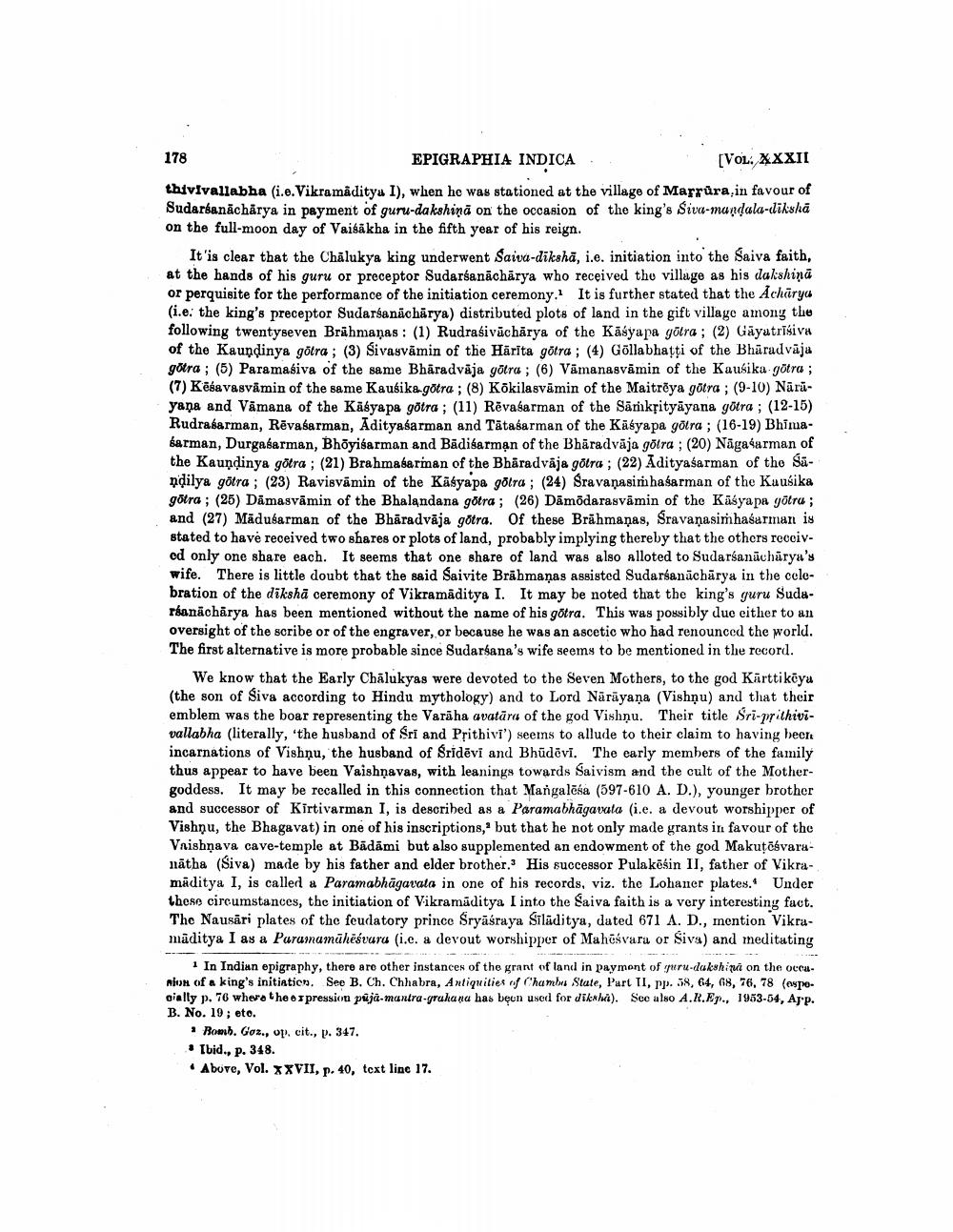________________
EPIGRAPHIA INDICA
[VOL. XXXII thivivallabha (i.e. Vikramaditya I), when he was stationed at the village of Marrura, in favour of Sudarsanacharya in payment of guru-dakshina on the occasion of the king's Siva-mandala-dikskā on the full-moon day of Vaisakha in the fifth year of his reign.
178
It is clear that the Chalukya king underwent Saiva-diksha, i.e. initiation into the Saiva faith, at the hands of his guru or preceptor Sudarśanacharya who received the village as his dakshinā or perquisite for the performance of the initiation ceremony. It is further stated that the Acharya (i.e. the king's preceptor Sudarsanacharya) distributed plots of land in the gift village among the following twentyseven Brahmanas: (1) Rudrasivacharya of the Kasyapa golra; (2) Gayatrisiva of the Kaundinya götra; (3) Sivasvamin of the Hārīta götra; (4) Göllabhatti of the Bharadvaja götra; (5) Paramasiva of the same Bharadvaja gōtra; (6) Vamanasvamin of the Kausika gōtra; (7) Kesavasvamin of the same Kausika götra; (8) Kōkilasvamin of the Maitreya gōtra; (9-10) Nārāyana and Vamana of the Kasyapa götra; (11) Rēvasarman of the Samkṛityayana götra; (12-15) Rudrasarman, Rēvasarman, Adityasarman and Tātaśarman of the Kasyapa gōtra; (16-19) Bhimasarman, Durgasarman, Bhōyisarman and Badisarman of the Bharadvaja gōtra; (20) Nagasarman of the Kaunḍinya götra; (21) Brahmasarman of the Bharadvaja götra; (22) Adityasarman of the Sanḍilya götra; (23) Ravisvamin of the Kasyapa götra; (24) Sravanasimhasarman of the Kausika götra; (25) Dāmasvamin of the Bhalandana götra; (26) Damodarasvamin of the Kasyapa götra; and (27) Madusarman of the Bharadvaja götra. Of these Brahmanas, Sravanasimhasarman is stated to have received two shares or plots of land, probably implying thereby that the others received only one share each. It seems that one share of land was also alloted to Sudarsanacharya's wife. There is little doubt that the said Saivite Brahmanas assisted Sudarsanacharya in the celebration of the diksha ceremony of Vikramaditya I. It may be noted that the king's guru Sudaréanacharya has been mentioned without the name of his götra. This was possibly due either to an oversight of the scribe or of the engraver, or because he was an ascetic who had renounced the world. The first alternative is more probable since Sudarsana's wife seems to be mentioned in the record.
We know that the Early Chalukyas were devoted to the Seven Mothers, to the god Karttikeya (the son of Siva according to Hindu mythology) and to Lord Nārāyaṇa (Vishnu) and that their emblem was the boar representing the Varaha avatara of the god Vishnu. Their title Sri-prithivivallabha (literally, 'the husband of Sri and Prithivi') seems to allude to their claim to having been incarnations of Vishnu, the husband of Śrīdēvi and Bhūdēvī. The early members of the family thus appear to have been Vaishnavas, with leanings towards Saivism and the cult of the Mothergoddess. It may be recalled in this connection that Mangalēša (597-610 A. D.), younger brother and successor of Kirtivarman I, is described as a Paramabhāgavata (i.e. a devout worshipper of Vishnu, the Bhagavat) in one of his inscriptions, but that he not only made grants in favour of the Vaishnava cave-temple at Badami but also supplemented an endowment of the god Makutesvaranatha (Siva) made by his father and elder brother. His successor Pulakesin II, father of Vikramaditya I, is called a Paramabhāgavata in one of his records, viz. the Lohaner plates. Under these circumstances, the initiation of Vikramaditya I into the Saiva faith is a very interesting fact. The Nausari plates of the feudatory prince Sryasraya Siladitya, dated 671 A. D., mention Vikramaditya I as a Paramamaheśvara (i.c. a devout worshipper of Maheśvara or Siva) and meditating
1 In Indian epigraphy, there are other instances of the grant of land in payment of guru-dakshina on the occanion of a king's initiation. See B. Ch. Chhabra, Antiquities of Chamba State, Part II, pp. 58, 64, 68, 76, 78 (especially p. 76 where the expression puja-mantra-grahana has been used for diksha). See also A.R.Ep., 1953-54, App. B. No. 19; etc.
Bomb. Goz., op. cit., p. 347.
Ibid., p. 348.
• Above, Vol. XXVII, p. 40, text line 17.




